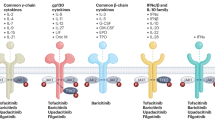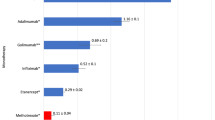Abstract
The management of rheumatoid arthritis has greatly improved in the past decade, owing to new treatment strategies and the introduction of agents that inhibit tumor necrosis factor (TNF). Unfortunately, a substantial proportion of patients will discontinue therapy with their first TNF inhibitor for various reasons (for example, non-response, loss of efficacy, or toxicity). Until recently, treatment options for these patients were limited and most rheumatologists chose to switch to treatment with an alternative TNF inhibitor. However, biologic agents with different modes of action have now become available. Hence, the dilemma now facing rheumatologists presented with patients who fail to respond to anti-TNF therapy is whether to switch to an alternative TNF inhibitor or to change to a biologic agent of a different drug class. This article discusses the evidence relating to these two options.
This is a preview of subscription content, access via your institution
Access options
Subscribe to this journal
Receive 12 print issues and online access
$209.00 per year
only $17.42 per issue
Buy this article
- Purchase on Springer Link
- Instant access to full article PDF
Prices may be subject to local taxes which are calculated during checkout
Similar content being viewed by others
References
Redlich, K. et al. Rheumatoid arthritis therapy after tumor necrosis factor and interleukin-1 blockade. Arthritis Rheum. 48, 3308–3319 (2003).
Hyrich, K. L. et al. Outcomes after switching from one anti-tumor necrosis factor α agent to a second anti-tumor necrosis factor α agent in patients with rheumatoid arthritis: results from a large UK national cohort study. Arthritis Rheum. 56, 13–20 (2007).
Gomez-Reino, J. J. & Carmona, L. Switching TNF antagonists in patients with chronic arthritis: an observational study of 488 patients over a four-year period. Arthritis Res. Ther. 8, R29 (2006).
Buch, M. H. et al. True infliximab resistance in rheumatoid arthritis: a role for lymphotoxin α? Ann. Rheum. Dis. 63, 1344–1346 (2004).
Smolen, J. S. et al. Golimumab in patients with active rheumatoid arthritis after treatment with tumor necrosis factor α inhibitors (GO-AFTER study): a multicentre, randomised, double-blind, placebo-controlled, phase III trial. Lancet 374, 210–221 (2009).
Genovese, M. C. et al. Abatacept for rheumatoid arthritis refractory to tumor necrosis factor α inhibition. N. Engl. J. Med. 353, 1114–1123 (2005).
Cohen, S. B. et al. Rituximab for rheumatoid arthritis refractory to anti-tumor necrosis factor therapy: results of a multicenter, randomized, double-blind, placebo-controlled, phase III trial evaluating primary efficacy and safety at twenty-four weeks. Arthritis Rheum. 54, 2793–2806 (2006).
Emery, P. et al. IL-6 receptor inhibition with tocilizumab improves treatment outcomes in patients with rheumatoid arthritis refractory to anti-TNF biologics: results from a 24-week multicentre randomised placebo controlled trial. Ann. Rheum. Dis. 67, 1516–1523 (2008).
Smolen, J. et al. Golimumab is efficacious in anti-TNF agent experienced patients with active rheumatoid arthritis regardless of type of agent or reason for discontinuation of prior anti-TNF agent: result from the GO-AFTER Study [abstract]. Ann. Rheum. Dis. 68 (Suppl. 3), 242 (2009).
Villeneuve, E. & Haraoui, B. Switching between TNF-α inhibitors in the treatment of rheumatoid arthritis. Int. J. Adv. Rheumatol. 4, 2–8 (2006).
Bombardieri, S. et al. Effectiveness of adalimumab for rheumatoid arthritis in patients with a history of TNF-antagonist therapy in clinical practice. Rheumatology (Oxford) 46, 1191–1199 (2007).
Remy, A., Avouac, J., Gossec, L. & Combe, B. Clinical pertinence of the switch to a second TNF inhibitor after failure of a first one in rheumatoid arthritis: a systematic literature review and meta-analysis [abstract]. Ann. Rheum. Dis. 68 (Suppl. 3), 230 (2009).
Furst, D. E. et al. Open-label, pilot protocol of patients with rheumatoid arthritis who switch to infliximab after an incomplete response to etanercept: the OPPOSITE study. Ann. Rheum. Dis. 66, 893–899 (2007).
Navarro-Sarabia, F. et al. DAS-28-based EULAR response and HAQ improvement in rheumatoid arthritis patients switching between TNF antagonists. BMC Musculoskelet. Disord. 10, 91 (2009).
Karlsson, J. A. et al. Treatment response to a second or third TNF-inhibitor in RA: results from the South Swedish Arthritis Treatment Group Register. Rheumatology (Oxford) 47, 507–513 (2008).
Keystone, E., Aranda, R., Becker, A.-C., Covucci, A. & Genovese, M. C. Abatacept provides clinical benefits in rheumatoid arthritis (RA) patients who previously demonstrated a lack of response or no response to one or more anti-TNF therapies [abstract]. Arthritis Rheum. 54 (Suppl.), S406 (2006).
Schiff, M. H. et al. The 6-month safety and efficacy of abatacept in patients with rheumatoid arthritis who underwent a washout after anti-tumour necrosis factor therapy or were directly switched to abatacept: the ARRIVE trial. Ann. Rheum. Dis. 68, 1708–1714 (2009).
Kremer, J. M. et al. Repeat treatment with rituximab in active RA patients: long-term efficacy in patients with one versus two or more prior TNF inhibitors [abstract]. Ann. Rheum. Dis. 66 (Suppl. II), 432 (2007).
Keystone, E. C. et al. Rituximab inhibits structural joint damage in rheumatoid arthritis patients with an inadequate response to tumour necrosis factor inhibitor therapies. Ann. Rheum. Dis. 68, 216–221 (2009).
Genovese, M. C. et al. Efficacy and safety of the selective co-stimulation modulator abatacept following 2 years of treatment in patients with rheumatoid arthritis and an inadequate response to anti-tumour necrosis factor therapy. Ann. Rheum. Dis. 67, 547–554 (2008).
Keystone, E. et al. Safety and efficacy of additional courses of rituximab in patients with active rheumatoid arthritis: an open-label extension analysis. Arthritis Rheum. 56, 3896–3908 (2007).
van Vollenhoven, R. F., Cullinane Carli, C., Augustsson, J. & Klareskog, L. Experience with rituximab in the treatment of rheumatoid arthritis (RA); results from the STURE registry [abstract]. Ann. Rheum. Dis. 67 (Suppl. II), 340 (2008).
Finckh, A. et al. B cell depletion may be more effective than switching to an alternative anti-tumor necrosis factor agent in rheumatoid arthritis patients with inadequate response to anti-tumor necrosis factor agents. Arthritis Rheum. 56, 1417–1423 (2007).
Finckh, A. et al. Which subgroup of patients with rheumatoid arthritis benefits from switching to rituximab versus alternative anti-tumour necrosis factor (TNF) agents after previous failure of an anti-TNF agent? Ann. Rheum. Dis. 69, 387–393 (2010).
Venkatachalam, S. et al. Rituximab may be more effective than switching to an alternative TNF inhibitor in rheumatoid arthritis patients who have failed other TNF inhibitors [abstract]. Rheumatology (Oxford) 47 (Suppl. 2), ii31 (2008).
Buch, M. H. et al. Is switching to rituximab more effective than switching to an alternative tumour necrosis factor blocking therapy (TNF-BT) in patients with rheumatoid arthritis (RA) who have failed a previous TNF-BT?—single-centre cohort experience [abstract]. Ann. Rheum. Dis. 68 (Suppl. 3), 574 (2009).
Chatzidionysiou, K., Carl, C. & van Vollenhoven, R. F. Rituximab versus anti-TNF in patients who previously failed one or more anti-TNFs in an observational cohort: the SARASTRA Study [abstract]. Ann. Rheum. Dis. 68 (Suppl. 3), 445 (2009).
Author information
Authors and Affiliations
Corresponding author
Ethics declarations
Competing interests
B. Haraoui has acted as a consultant for and received grants or research support from Abbott, Amgen, Bristol-Myers Squibb, Roche, Schering and Wyeth. E. Villeneuve declares no competing interests.
Rights and permissions
About this article
Cite this article
Villeneuve, E., Haraoui, B. To switch or to change class—the biologic dilemma in rheumatoid arthritis. Nat Rev Rheumatol 6, 301–305 (2010). https://doi.org/10.1038/nrrheum.2010.45
Published:
Issue Date:
DOI: https://doi.org/10.1038/nrrheum.2010.45
This article is cited by
-
Changes in the use patterns of bDMARDs in patients with rheumatic diseases over the past 13 years
Scientific Reports (2021)
-
Therapeutic Options After Treatment Failure in Rheumatoid Arthritis or Spondyloarthritides
Advances in Therapy (2014)
-
Primary lack of efficacy of infliximab therapy for rheumatoid arthritis: pharmacokinetic characterization and assessment of switching to tocilizumab
Modern Rheumatology (2011)
-
Outcomes of switching anti-TNF drugs in rheumatoid arthritis—a study based on observational data from the Finnish Register of Biological Treatment (ROB-FIN)
Clinical Rheumatology (2011)



